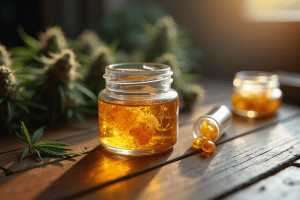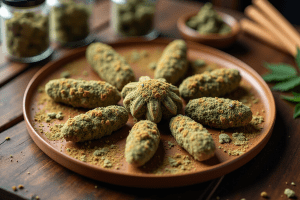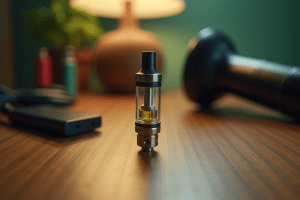Overview
In exploring the prices of a half ounce of weed, it’s essential to understand the significant differences between dispensaries and street vendors. Have you ever wondered why these prices vary so much? Dispensaries typically charge between $100 and $240. This higher cost reflects their commitment to quality assurance and legal compliance, ensuring that you receive safe and reliable products.
On the other hand, street prices can range from $80 to $150. While this may seem appealing, it often comes at the expense of safety and product reliability. It’s crucial to consider these factors when making your purchasing decisions. We want you to feel empowered to choose wisely, prioritizing your well-being.
As you navigate your options, remember that informed choices lead to better experiences. Together, let’s prioritize safety and quality in our cannabis purchases. Your health and peace of mind are worth it.
Introduction
In the ever-evolving landscape of cannabis consumption, understanding the nuances of purchasing options is essential for both seasoned users and newcomers alike. Have you ever felt overwhelmed by the choices available? A half ounce of weed, commonly known as a ‘half-O’, serves as a pivotal measurement that balances affordability with usability, making it a popular choice among consumers. However, the decision to buy from a legal dispensary versus a street dealer can significantly impact product quality, safety, and overall experience.
With price variations influenced by factors such as regulatory compliance and product testing, it’s important for us to navigate this complex market landscape together. This article delves into the key aspects of cannabis measurements, pricing dynamics, and the pros and cons of different purchasing avenues. By equipping ourselves with this knowledge, we can make informed choices in our cannabis journey, ensuring a safer and more enjoyable experience.
Define Half Ounce of Weed: Measurement and Context
A half ounce of weed price is often associated with a quantity that is roughly equivalent to 14 grams, commonly referred to as a ‘half-O’. This measurement is quite significant in the cannabis industry, as it represents a typical quantity associated with the half ounce of weed price purchased by both casual users and regular consumers. Understanding the half ounce of weed price is crucial for buyers; it helps them assess how much product they are getting and how it fits with their consumption habits.
Practically speaking, a half ounce can yield about 30 joints, depending on how they are rolled, making it a versatile choice for many users. This quantity strikes a balance between cost and usability, appealing to those who want to stock up at the half ounce of weed price without committing to a full ounce (28 grams). Furthermore, insights from industry experts emphasize the importance of understanding weed measurements, such as the half ounce of weed price, as they directly influence purchasing decisions and overall consumption strategies.
Have you considered how these measurements affect your choices? Connecting with a licensed physician through Leafy Mate can help you obtain a medical marijuana card, which not only allows for larger purchase limits but also offers potential tax savings. This understanding enhances the value of knowing these measurements. Notably, an ounce of weed could last anywhere from one month to six weeks, providing context for your consumption habits.
As Gregory T. Carter, MD, notes, new users may feel apprehensive about marijuana therapy. However, grasping these measurements can ease concerns about safety and efficacy. Additionally, the therapeutic potential of cannabis encourages responsible use and consultation with healthcare providers, ensuring that we make informed decisions in the evolving cannabis landscape. Together, we can navigate these choices with confidence.
Compare Half Ounce Prices: Dispensary vs. Street
The half ounce of weed price varies significantly between retail outlets and street vendors, influenced by factors such as quality, location, and adherence to regulations. In legal markets, you might find that the half ounce of weed price typically costs between $100 and $160, according to recent market studies. Some retailers may even charge up to $240 for premium options. For instance, in California, mid-tier strains usually hover around $150, while premium varieties can exceed $200. Conversely, the half ounce of weed price often ranges from $80 to $150, depending on the dealer and the quality of the product.
This notable price difference underscores the regulatory costs and quality assurance measures that dispensaries must maintain, which are often lacking in the street market. Understanding these dynamics is crucial for consumers who are exploring their options in the cannabis landscape. Moreover, obtaining a medical marijuana card can lead to potential savings of over 10% on purchases, as it often exempts cardholders from certain taxes.
As noted by the Zinnia Health Editorial Staff, while marijuana use has been decriminalized, it’s important to recognize that it can impact mental health. New consumers should also familiarize themselves with the types of dispensaries available. Medical dispensaries require a valid medical marijuana card, whereas recreational dispensaries cater to adults aged 21 and over without the need for a card. Dispensaries offer a variety of marijuana products, including:
- flower
- edibles
- concentrates
- vape cartridges
- topicals
- tinctures
By understanding the specific dynamics of local markets, you can gain the most accurate estimate for marijuana pricing, as prices can vary significantly based on location. It’s also essential to be aware that the legal limit for purchasing marijuana for recreational use in most U.S. states is one ounce. Together, let’s navigate this landscape thoughtfully and make informed choices.
Analyze Factors Influencing Price Differences
Understanding the various factors that contribute to the price variations between retail and street cannabis, including the half ounce of weed price, is essential. Legal establishments incur significant regulatory costs, including licensing fees, taxes, and adherence to health and safety standards. These costs are inevitably transferred to consumers, which results in increased prices, such as the half ounce of weed price, for retail items. Moreover, retail outlets generally provide lab-tested marijuana, ensuring quality and safety, which justifies the premium. In contrast, street dealers operate outside these regulations, allowing them to sell at lower prices, but often at the expense of quality and safety.
Navigating the landscape of marijuana stores is crucial for new cannabis consumers. Dispensaries are categorized into medical and recreational types, each serving different needs. Medical dispensaries cater to individuals with valid medical marijuana cards, offering products designed for specific health issues. Meanwhile, recreational dispensaries welcome adults aged 21 and older without requiring a medical card. This distinction is essential for understanding the variety of offerings available, including flower, edibles, concentrates, and more.
Geographic location also plays a crucial role in pricing. In areas with high demand or during peak seasons, the price of a half ounce of weed can surge due to limited supply. For instance, a case study on public health strategies for safer marijuana use highlighted that regulatory measures, such as limiting retailer density and implementing advertising restrictions, could influence market dynamics and pricing strategies. This study, approved by the KPNC Institutional Review Board, underscores the importance of regulatory impacts on pricing.
Furthermore, professional insights indicate that the guarantee of product quality in retail locations, in contrast to the uncertainty of street cannabis, greatly influences individuals’ willingness to pay elevated prices. A participant shared their experience, stating, “I have been visiting the same establishment for a while now. I told them I was pregnant because I was excited, and they were all supportive. I didn’t feel judgment from any of them.” This feeling illustrates the positive buyer experience at retail outlets, strengthening the advantages of selecting legal providers over street vendors.
In general, although retail outlets might have higher prices, the advantages of quality assurance, safety, and adherence to regulations offer a compelling motivation for individuals to choose legal sources instead of street vendors. Moreover, the idea of informed purchasers leading to enhanced business results emphasizes how knowledgeable decisions can positively impact pricing and practices within the industry.
Evaluate Pros and Cons: Dispensary vs. Street Purchases
When choosing between licensed shops and street vendors for cannabis purchases, buyers face various benefits and drawbacks. Have you noticed how 56% of shoppers have changed their buying habits due to rising living expenses? Many are now opting for safer, legal alternatives. This shift emphasizes the importance of understanding the advantages of retail outlets. These shops offer significant benefits, such as access to lab-verified products, knowledgeable staff, and a safe purchasing environment. At Leafy Mate, we are dedicated to helping you navigate this journey, ensuring you find high-quality marijuana that is both safe and effective, especially crucial in today’s market.
Additionally, licensed establishments provide a broader range of varieties and products, including edibles and concentrates, catering to diverse shopper preferences. However, it’s essential to consider that the half ounce of weed price, along with higher costs and potential limits on purchase amounts, might deter some buyers. On the other hand, street purchases may attract those looking for the half ounce of weed price and more flexibility in quantity. Yet, these advantages come with significant risks. Street marijuana often lacks safety testing, leading to lower quality products, and buying from street dealers can have legal repercussions, particularly in states like Washington, where plant possession is prohibited and specific limits on infused products are enforced, making the half ounce of weed price a potential factor in choosing lower-quality options. A study revealed that 7% of buyers are opting for often-cheaper, lower-quality flower, highlighting the risks associated with street purchases and the potential for unsafe products. Real-world examples illustrate these dynamics: individuals frequently express concerns about the quality and safety of street marijuana. Advocates emphasize the importance of purchasing from licensed outlets to mitigate these risks. Research also shows that consumers prefer legal cannabis with higher THC levels, suggesting that retail outlets should focus on providing a variety of potency options to meet demand.
Testimonials from satisfied Leafy Mate users reflect the peace of mind that comes from buying lab-tested products through our extensive directory of retailers. Ultimately, the choice between dispensary and street purchases depends on your individual priorities, including budget, quality assurance, and legal considerations. With Leafy Mate by your side, you can confidently explore your options, knowing you have access to a trusted resource for premium cannabis products. Together, let’s make informed choices that prioritize your safety and satisfaction.
Conclusion
Understanding the intricacies of cannabis purchasing is vital for both new and seasoned users. The half ounce, or ‘half-O’, serves as a crucial measurement that balances quantity and cost, appealing to a wide range of consumers. By knowing this measurement, you can better assess your personal consumption needs and appreciate the importance of consulting with healthcare providers for safe and effective use.
Price variations between dispensaries and street dealers highlight significant differences in quality, safety, and regulatory compliance. While dispensaries may charge more due to their adherence to strict regulations and quality testing, the benefits of purchasing from a legal source far outweigh the lower prices often found on the street. The assurance of product safety and the diverse range of available options at dispensaries provide consumers with a more secure and informed experience.
Ultimately, where you choose to purchase cannabis should be guided by your individual priorities. Consider factors such as budget, quality assurance, and legal implications. With the right knowledge and resources, such as those offered by platforms like Leafy Mate, you can navigate the cannabis landscape confidently. This ensures that your choices lead to a safer and more enjoyable experience.
As the cannabis market continues to evolve, informed purchasing decisions will play a crucial role in shaping a responsible and thriving community of users. Together, let’s make choices that foster safety and enjoyment in our cannabis experiences.
Frequently Asked Questions
What is a half ounce of weed and how much does it weigh?
A half ounce of weed is roughly equivalent to 14 grams, commonly referred to as a ‘half-O’.
Why is understanding the half ounce of weed price important for buyers?
Understanding the half ounce of weed price helps buyers assess how much product they are getting and how it fits with their consumption habits.
How many joints can a half ounce of weed yield?
A half ounce can yield about 30 joints, depending on how they are rolled.
What are the benefits of purchasing a half ounce of weed?
A half ounce strikes a balance between cost and usability, appealing to users who want to stock up without committing to a full ounce (28 grams).
How does understanding weed measurements influence purchasing decisions?
Insights from industry experts emphasize that understanding weed measurements, such as the half ounce of weed price, directly influences purchasing decisions and overall consumption strategies.
How can obtaining a medical marijuana card benefit consumers?
A medical marijuana card allows for larger purchase limits and offers potential tax savings for consumers.
What is the typical duration an ounce of weed can last?
An ounce of weed could last anywhere from one month to six weeks, providing context for consumption habits.
What should new users consider regarding marijuana therapy?
New users may feel apprehensive about marijuana therapy, but grasping measurements can ease concerns about safety and efficacy while encouraging responsible use and consultation with healthcare providers.
Get Your Medical Card
Connect with a licensed physician online in minutes












